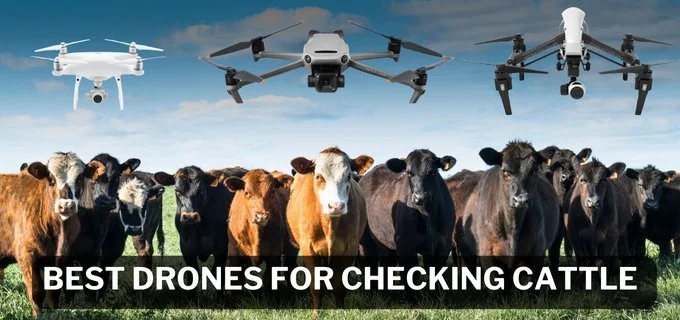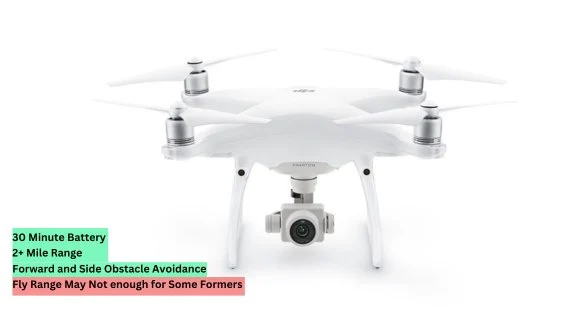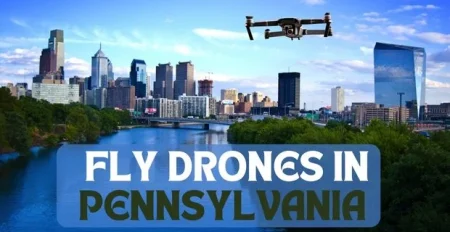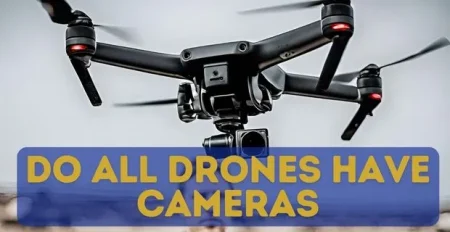
If you find it challenging to monitor your cattle, the conventional methods of livestock management may appear laborious and time-consuming.
Traditional cattle monitoring entails laborious hours navigating open fields, dense thickets, and challenging weather conditions while attempting to track a constantly grazing and moving herd.
Best Drones For Checking Cattle
Fortunately, there is a growing trend in several countries where the use of drones for livestock monitoring is gaining momentum. Australia and Israel have already embraced the use of numerous cattle monitoring drones, employing them for various purposes, from military tasks to agricultural surveillance.
This rapid wave of technological innovation is revolutionizing these age-old practices, ushering in the era of drones in agriculture.
Drones provide a bird’s eye view of the ranch and empower Farm Workers with unprecedented surveillance capabilities, particularly for livestock monitoring.
This article aims to inform farmers and ranchers about the potential of using the best drones for cattle monitoring.
The Role of Drones in Cattle Management
In the context of managing livestock, drones are more than mere flying machines. They have rapidly become an integral tool in a farmer’s arsenal, simplifying several aspects of cattle management.
Drones excel in tasks such as regular monitoring and counting of cattle. Traditionally, these chores would have required cattlemen to traverse extensive pastures, often in adverse weather conditions manually. With a drone, however, one can perform these duties remotely, accurately, and in a fraction of the time.
Drones are a boon when it comes to locating lost or stray cattle. Drones can help farmers quickly identify and guide stray cattle back to the herd, even in the most rugged terrains or dense undergrowths.
Using drones in cattle management offers several advantages over traditional methods. The increased efficiency in operations allows farmers to dedicate their time and resources to other important tasks. The reduction in labor costs can result in significant savings over time. Furthermore, with drones reducing the need for direct human-animal interactions, the stress on the animals is minimized, leading to improved animal welfare.
Top Products:
How Drones Are Useful For Cattle Checking
Drones have many benefits for cattle checking, transforming how farmers manage and monitor their herds or castles. Here’s how drones can be incredibly useful:
Efficient Monitoring:
Drones allow farmers to monitor their herds from above, providing a comprehensive overview of all the cattle in one shot. It drastically reduces the time it takes to check on the animals, especially in large or scattered herds.
Locating Lost or Stray Cattle:
Drones can quickly cover vast distances, making finding lost or stray animals easier. It is especially useful in rugged terrains or large pastures where manually searching for cattle can be time-consuming and labor-intensive.
Early Health Issue Detection:
Drones are usually equipped with high-resolution cameras and, occasionally, thermal sensors. And they can capture detailed images of cattle, enabling farmers to identify early signs of sickness, injury, or stress. Timely detection can lead to quicker treatment, improving the chances of recovery.
Counting and Inventorying:
Drones can be used to count and keep track of cattle, which is a particularly beneficial feature for large herds. Accurate counting can help farmers manage their inventory more effectively.
Reduced Stress for Animals:
Traditional methods of checking cattle often involve close human interaction, which can cause stress in some animals. Drones allow for a non-invasive way to monitor the herd, reducing animal stress.
Reduced Labor and Time:
Using drones for cattle checking significantly reduces the need for manual labor, freeing up farm workers to focus on other important tasks. It also reduces the time spent on cattle checking, making the overall process more efficient.
Cost-Effective:
Although there is an initial investment, drones can be a cost-effective solution in the long run. The potential for reduced labor costs, enhanced herd health, and increased efficiency can result in substantial savings over time.
Enhanced Safety:
Using drones to check on cattle, especially in difficult terrains or during harsh weather conditions, keeps farmers and ranch hands safe as they can monitor the herd from the safety and comfort of a remote location.
Data Collection and Analysis:
Advanced drones can collect data about the herd and its environment, helping farmers make informed decisions about feeding, medical treatment, and general management.
How to Choose a Drone for Cattle Checking
Investing in a drone for cattle checking is a significant decision, and farmers should consider several key features.
Flight time and battery life: Longer flights allow extensive surveys of large cattle ranges while quick-charging or replaceable batteries minimize downtime.
Camera quality: High-resolution cameras capture detailed imagery for early detection of health issues, and thermal imaging capabilities are beneficial for low light conditions.
Durability and weather resistance: Durable drones are designed to withstand severe weather conditions, ensuring reliability and longevity. In this article, we have already featured a waterproof drone, and you can also explore additional options.
Range and signal strength: A strong signal and wide range are necessary for drones to travel far from the controller while maintaining a stable connection, especially on large ranches.
Ease of use and control features: Intuitive control systems and autonomous flight capabilities are important for beginners, making the learning curve smoother.
Autonomy and GPS capabilities: Drones with autonomous flight paths, waypoint navigation, and GPS tagging can perform complex tasks like tracking specific cattle or surveying predefined areas.
Top Drones for Cattle Checking
To assist you in finding the right tool for your cattle management needs, we’ve analyzed some of the best drones currently available. We’ll examine their specifications, strengths, weaknesses, and how they might benefit your specific situation.
1. DJI Mavic 3 Classic Review: Perfect for Cattle Monitoring

REASONS TO BUY
✓Great Range
✓Good Camera when searching Lost Cattle
✓Omnidirectional Obstacle Sensing
✓Return to Home
REASONS TO AVOID
✗Not suitable for Night use
The DJI Mavic 3 Classic is an amazing drone with excellent features for cattle monitoring. Its impressive range, advanced camera capabilities, and obstacle-sensing technology provide a comprehensive solution for farmers and ranchers.
Range:
The Mavic 3 Classic boasts an exceptional feature that sets it apart: an impressive range enabling flights of up to about 15km. This extensive coverage enables farmers to monitor large land areas efficiently and effectively, ensuring that no part of the herd goes unnoticed. The extended range benefits those with expansive cattle ranches or grazing pastures.
Camera
Equipped with a top-quality camera, the Mavic 3 Classic captures stunning 5.1K HD video, providing detailed footage for cattle assessment. This high-resolution imagery clearly shows the animal’s health, behavior, and overall well-being. The camera’s advanced capabilities enable farmers to closely analyze the condition of their cattle, identify any signs of distress, and make informed decisions regarding their management.
Obstacle Sensing
The Mavic 3 Classic also features omnidirectional obstacle sensing, which enhances flight safety and reduces the risk of collisions. It is equipped with sensors on all sides, and the drone can detect and evade obstacles encountered during flight, including trees, buildings, and other objects.
This feature is crucial when flying in challenging environments or near structures, ensuring the drone can navigate precisely and accurately.
It is equipped with an automated return-to-home feature to enhance safety and reduce the risk of losing the drone. This functionality ensures that the drone will automatically return to its takeoff point in situations such as low battery, signal loss, or user command. This feature brings peace of mind, particularly when operating in remote areas or encountering unforeseen circumstances.
Downside:
While the Mavic 3 Classic offers exceptional performance and features, it’s worth noting that it doesn’t have a thermal imaging option. Thermal imaging can be particularly useful for cattle monitoring during the night, as it enables farmers to identify the heat signatures of the animals and locate them even in low-light conditions. However, the Mavic 3 Classic compensates for this by excelling in other areas, making it a versatile and valuable tool for daily cattle monitoring.
Verdict
The DJI Mavic 3 Classic is a highly capable drone specifically designed to meet the needs of farmers and ranchers engaged in cattle monitoring. Its extensive range, excellent camera quality, obstacle sensing technology, and reliable Return to Home function make it an ideal choice for comprehensive and efficient livestock management. While thermal imaging may be missing, the Mavic 3 Classic’s overall performance and features make it a valuable asset in cattle monitoring operations.
2. The Yuneec H520 Drone

REASONS TO BUY
✓Three camera choices with superior picture quality
✓4K video capture at 60 frames per second
✓Mapping capabilities and pre-set flight paths
✓Impressive flight behavior with an extended battery life of about 25 minutes
✓Light-sensitive and thermal imaging cameras with a 3-axis gimbal offering continuous 360° rotation
✓Lightweight
REASONS TO AVOID
✗No team mode – restricting two operators from controlling the drone
✗High-cost
✗Odd battery level alert – initiates self-landing at 25-30% battery
The Yuneec H520, a hexacopter designed for commercial purposes, is an excellent choice for those requiring extended flight durations and robust, reliable technology in a comprehensive package. It’s ideal for sectors like law enforcement, construction, inspection, surveying, and security, and certainly for farmers who need to monitor their livestock and crops.
Design
The foldable design of the H520 shares similarities with the Typhoon H: its six motor arms can be folded, considerably reducing the device’s size during transport. The landing gear, too, is retractable and remains in the lowered position in this state.
Remote Control
The remote control of the H520 is a technological marvel. The ST16S operates on Android and showcases the drone camera’s live video in 720p-HD on a 7-inch touchscreen.
Its “DataPilot” app is purpose-built for mapping missions, processing maps from diverse providers, and using them offline.
Light in Weight
This is a lightweight drone. Regardless of the camera attached, the Yuneec H520’s launch weight remains under two kilograms. As a result, pilots of the H520 are not mandated to hold a drone driver’s license.
The Yuneec H520 stands out with its front sensors that automatically stop the drone before encountering any barriers – an especially handy feature when flying close to buildings or trees.
Is Yuneec H520 Suitable for Checking Cattle?
The H520 is a stable and responsive drone whose camera facilitates 360° rotation. It’s an ideal pick for those who appreciate high-quality aerial images. Despite the absence of automated shooting sequences, it gives you total control. With the inclusion of the thermal imaging camera CGO ET, Yuneec has designed an impressive piece of equipment for farmers to monitor their livestock effectively.
3. Phantom 4 Pro V2 Drone Review: Best for Livestock Monitoring

REASONS TO BUY
✓30 Minute Battery
✓2+ Mile Range
✓Forward and Side Obstacle Avoidance
REASONS TO AVOID
✗Fly Range May Not be enough for Some Formers
The Phantom 4 Pro, Version 2 Drone by DJI, is a top-tier, professional-grade drone that brings a lot regarding aerial surveillance and cattle checking.
Camera
Its 20 MP camera and its ability to capture 4K video provide high-resolution, detailed imaging. This allows for effectively monitoring large herds, where the fine details matter. Farmers can easily assess their cattle’s health, spot any signs of disease or distress, or identify stray or lost animals. This superior camera technology makes it a reliable tool for detailed visual assessments, which is critical in cattle management.
Obstacle Sensors
Another notable feature is the drone’s four-direction obstacle avoidance sensors. These sensors provide an added layer of safety when flying the drone close to trees, buildings, or other potential hazards in farming environments. It ensures that your drone remains intact and functional, safeguarding your investment.
Speed
With a top speed of 40 mph, the Phantom 4 can swiftly cover vast land areas, making it suitable for farmers with large pastures. The 3-mile range further allows the drone to check on cattle in distant fields without needing the operator to move from their current location.
Remote Control
The DJI Remote control is user-friendly and comes with a battery charger, ensuring your drone is always ready for flight. However, the real highlight is the DJI Crystal Sky. This 7.8-inch Daylight readable screen offers the best visibility among all tablets. Adding third-party software might be challenging, and it could be a more rugged option, but the superior screen quality offers clarity and readability in bright sunlight, which is critical for outdoor use.
The Rescue Finder is an essential feature for those unexpected mishaps. It’s radio transmitter and tracking device has a range of up to 2 miles without GPS, increasing the chances of locating and recovering your drone if it gets lost or encounters trouble.
Water Proof:
As for accessories, the Phantom 4 Pro comes with a water-resistant backpack for convenient transportation and storage of the drone and all its accessories. This is a real boon for farmers who may have to move between different parts of their land.
Accessories:
The extra propellers and spare gimbal cover add to the appeal by providing replacements if needed. The USB cords ensure you have everything necessary for charging and data transfer.
Verdict:
The Phantom 4 Pro, Version 2 Drone is a comprehensive, reliable, and efficient tool for livestock checking. It offers advanced features and practical accessories that make cattle monitoring a breeze. High-resolution imaging, long-range, and safety features are just what farmers need for successful, stress-free cattle management.
4. DJI CP.BX.000103 Inspire

REASONS TO BUY
✓Capable of achieving a radio range of 1.2 miles
✓Features an Intelligent Flight Battery
✓Equipped with a 3-axis gimbal camera
✓Retractable carbon fiber arms for easy storage and transportation
REASONS TO AVOID
✗Limited range capability
Finding drones specifically designed for livestock assessment can be daunting in the saturated drone industry, where countless companies produce high-quality and counterfeit products. We proudly present the DJI Inspire to ensure that you invest in a reliable, high-performing drone for cattle monitoring.
Design
The DJI Inspire features carbon fiber arms that are 100% retractable, providing enhanced portability and easy storage. This design allows for hassle-free transportation, ensuring that the drone is readily available when you need it.
Arial Result
Equipped with a top-of-the-line gimbal, the camera on the DJI Inspire captures high-quality still images and videos, enabling you to obtain a better perspective on your cattle. Whether you are an amateur or professional cattle enthusiast, Inspire’s user-friendly flying capabilities cater to both, making it an accessible choice. Additionally, its four propellers ensure effective flight performance even in misty weather conditions.
With its outstanding charge-keeping technology, the DJI Inspire boasts impressive reliability, allowing for extended usage without worrying about running out of battery power. The drone utilizes eight quality motors, providing excellent propulsion and precise control, ensuring a smooth flight experience.
Use Cases and Success Stories
Farmers around the globe have already started implementing drones into their cattle management practices. For instance, a cattle rancher in Texas managed to cut his labor costs by 40% within a year of implementing drone technology.
The drone also helped him identify and treat sick cattle sooner, leading to an overall improvement in herd health.
Another farmer in Australia, operating in rugged terrain, used a drone to locate and guide back stray cattle, saving countless hours previously spent on manual searching. The ability to quickly find and retrieve stray cattle reduced the farmer’s loss rates and increased the overall productivity of his farm.
Legal and Ethical Considerations
Before using drones for farming, it is important to check the local laws and regulations about drone usage. Some regions may require permits, while others may restrict drone flight times or altitudes.
Also, it’s important to consider ethical aspects. While drones can improve animal welfare by reducing stress, they should be used responsibly to avoid causing fear or disturbance in cattle. Similarly, consider privacy concerns if your drone captures imagery beyond your property.
Frequently Asked Questions
What is the best drone for tracking animals?
Several drones are well-suited for animal tracking, but the DJI Matrice 300 RTK stands out due to its advanced AI capabilities, long flight time, and high-quality camera. However, the best drone depends on your specific requirements, such as your budget, the size of the area to be covered, and the data you need to collect.
How are drones used in cattle?
Drones are used in cattle management in several ways. They help efficiently monitor and count the herd, detect health issues or injuries early, and locate lost or stray cattle. They also collect data about the herd and its environment, facilitating informed decision-making about feeding, medical treatment, and general management.
How far can a drone track?
The range of a drone depends on its model and specifications. Professional-grade drones, like the DJI Matrice 300 RTK, can fly up to 15 kilometers from the controller.
What is a cow drone?
A ‘cow drone’ is a colloquial term used to describe drones used in cattle management. These drones are equipped with cameras and sometimes additional sensors to monitor cattle herds, track their movement, check their health, count them, and locate any lost or stray cattle.
Do drones scare cattle?
Generally, cattle seem to exhibit minimal stress or fear response to drones, especially when the drones are flown at higher altitudes. However, the response can vary based on the cattle’s familiarity with drones and the drone’s flight pattern and altitude. Flying drones at a reasonable height is recommended to minimize potential stress on the cattle.
Conclusion
We have shared our in-depth research and experience regarding the best drones for checking cattle. Through careful examination of various drones and their features, we have identified the key factors to consider when selecting a drone for livestock monitoring.
These Drones offer significant advantages in terms of efficiency, accuracy, and cost savings for farmers and ranchers. With features like high-resolution cameras, obstacle-sensing technology, extended range, and intelligent flight modes, these drones empower users to monitor their cattle precisely and easily.
While different drones excel in specific areas, such as long flight time, thermal imaging capabilities, or advanced mapping features, the ultimate choice depends on individual needs and preferences.
Whether it’s the DJI Matrice 300 RTK, Autel Robotics EVO II, or DJI Mavic 2 Pro, the drone revolution in livestock management is here to stay, enabling farmers to take their cattle monitoring to new heights.











